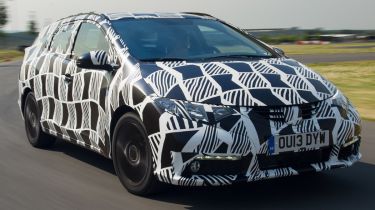New Honda Civic Tourer review
We take a spin in a prototype of the 2014 Honda Civic Tourer to see how it's shaping up

There's no lack of competition for the new Civic Tourer, with new estate versions of the VW Golf, Skoda Octavia and SEAT Leon set to be on sale by the time it arrives. But this early car shows real promise and Honda Europe has managed to improve the dynamics significantly. The clever new suspension is an added bonus, but the real selling points will be the enormous boot, smart and flexible storage solutions and fleet-friendly emissions. Buyers in the market for a compact estate should watch this space.
The new Honda Civic Tourer won’t go on sale until early next year, but Honda invited Auto Express to drive a pre-production prototype to give us an idea of how it’s shaping up to take on fresh rivals like the VW Golf Estate.
Sadly, Honda wouldn’t tell us exactly how big the Tourer’s boot is, but having seen it first-hand and noted the enormous space hidden underneath the floor, we’re confident that it’ll better the 610 litres of the current class leader – the Skoda Octavia Estate.
It incorporates some handy functionality to help give the car an edge over its rivals, too. The hatch’s ‘magic’ flip up seats are carried over, and the extended roofline has boosted headroom in the rear seats dramatically.
Used - available now

2021 Lexus
UX 300e
22,738 milesAutomaticElectric
Cash £16,063
2023 Peugeot
3008
27,941 milesAutomaticDiesel1.5L
Cash £18,497
2022 BMW
X1
46,719 milesAutomaticDiesel2.0L
Cash £18,097
2020 Hyundai
Ioniq hybrid
45,952 milesAutomaticPetrol1.6L
Cash £12,497By far the biggest change over the new Honda Civic hatchback, though, is to the way this car drives. It’s been designed and developed for European tastes, and is a far bigger improvement over the standard car than we expected. Everything from the spring rates, dampers and steering settings has been tweaked to improve ride comfort, high-speed stability and handling.
A quick drive reveals weightier steering that provides more consistent feel and reassuring composure through bends. There’s now more of a suppleness to the damping over rough and bumpy surfaces that helps transform this car into more of a cosseting cruiser.
Combine that with neater body control and a short-shift gearbox, and the Tourer is marginally more fun. Honda is also giving buyers the option of a new adaptive damping system (ADS), allowing buyers to choose between three levels of stiffness: Comfort, Normal and Dynamic. Flicking between them only alters the rear axle, and while the changes are pretty insignificant we thought the ride in Comfort mode was up there with the best in class.
The ADS also compensates for heavy loads in the boot, helping to ensure the handling is affected as little as possible. Honda plans to offer it as a standalone option, but because it only works on the rear wheels, it’s lighter than the £800 ACC system on VW’s Golf Estate and likely to cost half as much.
The 2.2-litre i-DTEC diesel is not compatible with Euro VI emissions regulations and this engine won’t be offered on the Tourer, even though the hatch gets it. As a result the model we tested was powered by the clean and punchy 118bhp 1.6 i-DTEC. It revs smoothly and gives good in-gear acceleration, too, but can get rather noisy. Still, it’s also very efficient and if the finished car can come close to matching the 78.5mpg of the five-door hatch, it’ll be one of the cleanest estates on the market.
Due to the camouflage we can’t say much about the styling, but Honda says the final car will stick closely to the striking Geneva Motor Show concept, with the same single-piece brake lights and wraparound rear screen. The cabin is probably the only lingering weak point. The split level screens and awkward ergonomics are far from ideal. Otherwise, this car shows a lot of promise and bodes well for Honda’s fortunes in Europe.







